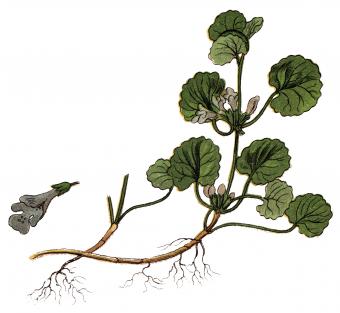
Creeping Charlie (Glechoma hederacea) is considered an invasive weed to lawn enthusiasts. This low-growing plant is an unwanted ground cover often called ground ivy.
How to Identify and Get Rid of Creeping Charlie
There are easy ways to identify Creeping Charlie; however, there is no easy way to get rid of this highly invasive plant. When you recognize the plant, you'll quickly discover its distinct minty aroma identifying it as a member of the mint family.

Creeping Charlie Distinguishing Features
The first thing you'll notice is the shape of the leaves is like a cat's paw. In fact, it's often referred to as catspaw. The leaves are soft, round to kidney shapes and fan out to smooth, rounded edges. There is an almost hairy-like texture to the leaves.
Colors of Creeping Charlie
Creeping Charlie can appear bright lime green like new spring green or a dark rich green. The flowers range from dark purple to a light lavender color. You won't mistake the funnel-shaped flowers that are prevalent in the spring until early summer. Another distinguishing feature is the stem, which is a decidedly square shape.

Strong Roots
Creeping Charlie has strong roots and spreads across the ground in a mat-like texture. It typically dies back during the winter and returns invigorated, lush and green in the spring.
Self-Propagating
What makes this plant so intense and invasive is its ability to propagate. This is accomplished two ways. The first is through seeding and the second, via rhizomes (underground horizontal stems with lateral shoots). It's this underground system with upward shoots that creates the woven mat effect that chokes out other plant life, such as grass lawns.
Impervious to Lawn Mower
One reason lawn lovers become so frustrated with Creeping Charlies is because it's impervious to a lawn mower. In addition, it is also difficult to kill with some herbicides. It seems to have a natural or built-up resistance to chemical poisons. The biggest concern when using chemicals to kill Creeping Charlie is how these same chemicals are not discriminating and will damage to your lawn is a given.
Methods for Getting Rid of Creeping Charlie
There are a few methods often given for removing and getting rid of Creeping Charlie. These include natural and chemical methods with varying results.

Hand-Pull Plants
Hand-pulling the vines and burning the plants to prevent them from re-rooting themselves is one method often recommended. However, it's nearly impossible to accomplish this if the plant has rooted itself in your yard. The plant is very strong and resistant to this type of method. You'll grow exhausted long before you succeed in eradicating this plant from your yard.
Vinegar, Salt and Dishwashing Soap
The mixture of white vinegar, table salt and dishwashing liquid soap will kill weeds and any unwanted plant. You need to mix one-gallon white vinegar, one cup of table salt and one tablespoon of dishwashing liquid soap. The soap will ensure the solution sticks to the leaves. This method gives results in a couple of days. You'll need to repeat frequently to prevent the shoots from emerging from the rhizomes.
Borax and Water
A mixture of borax and water to spray directly on the plants. Like any type of killing agent, other plants in the same vicinity will die. If you succeed in stopping the spread of the plant, you'll need to continually repeat the spray to ensure this fast-growing plant doesn't take over once more. The National Gardening Association warns this can result in creating a hot spot, where the borax runs off into lower-lying areas and accumulates to burn the roots of healthy grass.
More Grass and Fertilizer
Another method often touted as a good solution is to throw more grass seed onto the lawn, water and fertilize it. The main problem with this remedy is Creeping Charlie will also benefit from the water and fertilizer.
Herbicides Extreme Measure
According the Wisconsin Horticulture Extension, a postemergence broadleaf herbicide is the most commonly used method. This is an extreme solution and will result in damage to your lawn.
Another Way to View Creeping Charlie Mint
While lawn gardeners find Creeping Charlie a frustrating eyesore, herbalist and healers consider Creeping Charlie a blessed medicinal plant. It can be eaten in salads and soups. Like other mint plants, Creeping Charlie has a decided minty flavor and aroma.

Some of the traditional uses for Creeping Charlie include:
- Teas: Made from the leaves, a tea is used as a blood purifier and to treat migraines and kidney ailments.
- Tonics: A tonic made from the leaves is used to prevent scurvy since it's very high in Vitamin C.
- Poultice: The leaves are pulverized and used in a poultice for bruising and various lung infections.
- Beer making: Before hops were used, Creeping Charlie was used in the brewing of beer and ale.
How to Identify and Try to Get Rid of Creeping Charlie
Creeping Charlie is nearly impossible to eradicate from your lawn and yard. Many people believe the battle is lost by the time you notice this member of the mint family has crept into your space.







